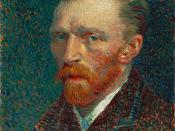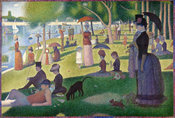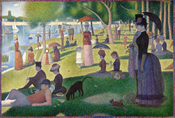Art History III The Impressionism movement was thought superior to all others in its attempt to develop a technique that brought a new kind of realism to painting and sculpture. It wasn't until French painter George Seurat began his exploration of pointillism, also known as divisonism in the late 19th century that Impressionism was brought to it's new level of Neo Impressionism.
During his lifetime Georges-Peirre Seurat experimented with many techniques. First studying at the "Ecole des beaux-arts" institute in France, he was strongly influenced by Dutch painter Rembrandt Harmenszoon Van Rijm's mastery of light and shadows. Also while at the institute Seurat found a powerful pull towards Spanish painter Francisco de Goya's bold, classic style. By intertwining these two well known Neo Classical painters styles George Seurat now had the beginnings of a technique that would consume most of his short life, and mark him as the ultimate example of scientific artist.
Georges-Peirre Seurat used his pointillism technique to produce seven grand paintings and sixty smaller ones along with over five hundred drawings and several sketchbooks. Georges Seurat first began his pointillism technique by studying colour theories and linear structures, then by incorporating tiny brush strokes of contrasting colour to portray light. The use of this technique resulted in loosened strokes of pure colour too small to be visible when looking at the entire works but making the paintings beam with brilliancy.
Of Seurats' works, "Un dimanch apreas-midi a I'lle de la Grande Jatte" (Sunday afternoon on the Island of La Grande Jatte, circa 1886) is one of his more well known paintings; Seurat has taken care in the use of stereotypical Impressionistic primary colours to simulate actual reflected light, added with the defined extent of colour he used based on the wide range of the spectrum.
By adding...


